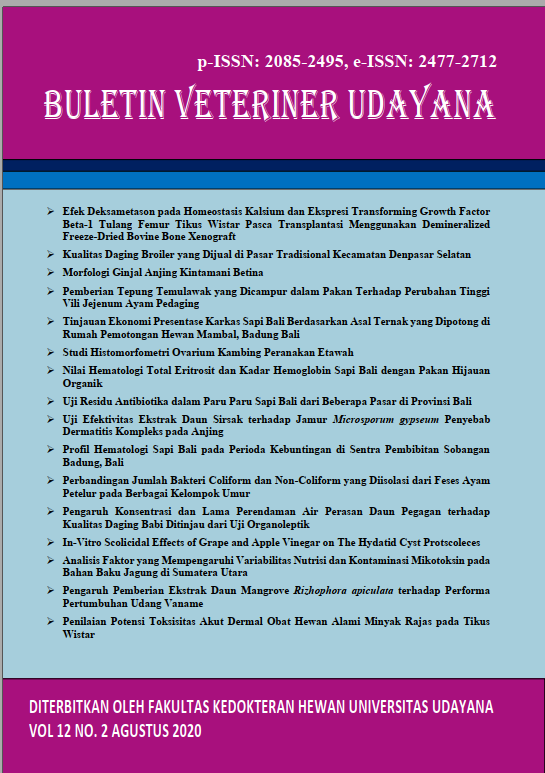ANTIBIOTIC RESIDUAL TEST IN LUNGS OF BALI COWS FROM SOME MARKETS IN BALI PROVINCE
Abstract
The use of antibiotics in inappropriate cattle ranches, for example, excessive doses, and no regard for drug withdrawal can cause antibiotic residues in the flesh and also the organs in livestock. The withdrawal time is the period from the last drug delivery to the livestock before the animal can be slaughtered so the meat and internal organs can be consumed. The lung is one of the internal organs distributed antibiotics that when not pay attention to the time of stopping the drug at the time of cutting the lung organ will still contain active substances from these antibiotics that cause the presence of antibiotic residues. This study aims to determine the presence of antibiotic residues in the lungs of bali cattle from several markets in Bali province. 30 lung samples were taken from several markets in five districts of Tabanan, Gianyar, Buleleng, Jembrana, and Karangasem and then tested using the bioassay method at Balai Besar Veteriner Denpasar. The results showed that 30 lung samples did not contain antibiotic residues of the penicillin, aminoglycoside, tetracycline, and macrolide groups.
Downloads
References
Besung INK, Watiniasih NL, Mahardika GNK, Agustina KK, Suwiti NK. 2019. Mineral levels of bali cattle (Bos javanicus) from four different type of land in different rearing areas. Biodiversitas, 20(10): 2931-2936.
Chattopadhyay MK. 2014. Use of antibiotics as feed additives: a burning question. Front. Microbiol., 5(334): 1-3.
Dewi AAS, Agustini NLP, Dharma DMN. 1997. Survei residu obat perparat sulfa pada daging dan telur ayam di Bali. Buletin Vet., 10(51): 9-14.
Donkor ES, Newman MJ, Tay SCK, Dayie NTKD, Bannerman E, Olu-Taiwo M. 2011. Investigation into the risk of exposure to antibiotic residues contaminating meat and egg in Ghana. Food Cont., 22(6): 869-873.
Doul’s C. 1996. Toxycology The Basic Science of Poisons Curtis D. Klaassen. 5th Ed. Health Profesion Division. Mc. Graw- Hill. New York
Katzung BG. 2007. Basic and Clinical Pharmacology. 10th Ed. United States: Lange Medical Publications.
Kussoy VFM, Kundre R, Wowiling F. 2019. Kebiasaan makan makanan tinggi purin dengan kadar asam urat di puskesmas. J. Keperawatan, 7(2): 1-7.
Maron, DF, Smith, TJ, Nachman, KE. 2013. Restrictions on antimicrobial use in food animal production: an international regulatory and economic survey. Glob. Health, 9(48): 1-11.
Martel AC, Zeggane S, Drajnudel P, Faucon JP, Aubert M. 2006. Tetracycline residues in honey after hive treatment. Food Additives Cont., 23(3): 265-273.
Masrianto, Fakhrurrazi, Azhari. 2013. Uji residu antibiotik pada daging sapi yang dipasarkan di pasar tradisional Kota Banda Aceh. J. Med. Vet. 7(1): 13-18.
Murtidjo BA. 2007. Pengendalian dan Hama Penyakit Ayam. Kanisius: Yogyakarta. Pp. 24-26.
Nugroho RH, Yulfitria HB. Dannoviarti S. 2002. Cemaran residu antibiotika dalam bahan pangan asal hewan di wilayah kerja BPPV Regional II Bukittinggi. Periode 1997-2002. Bulletin Inform. Kes. Hewan. 4(64): 1-4.
Phillips I, Casewell M, Cox T, Groot B, Friis C, Jones R, Nightingale C, Preston R, Waddell J. 2004. Does the use of antibiotics in food animals pose a risk to human health? J. Antimicrob. Chemotherapy, 53: 28-52.





